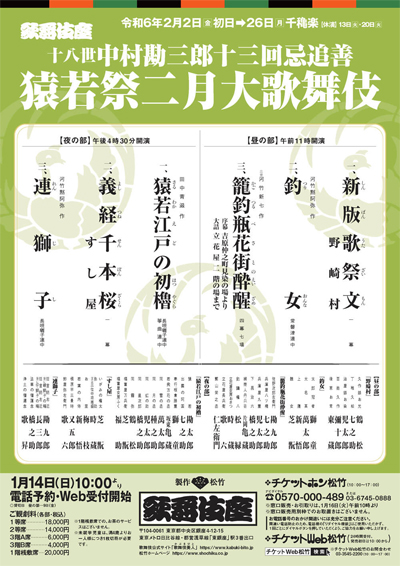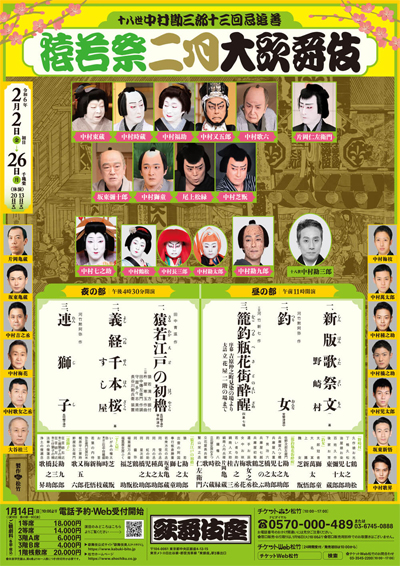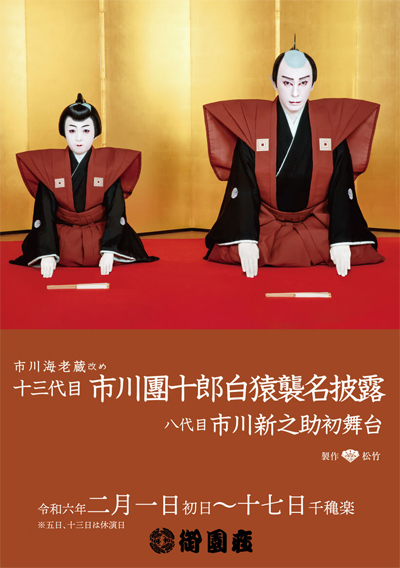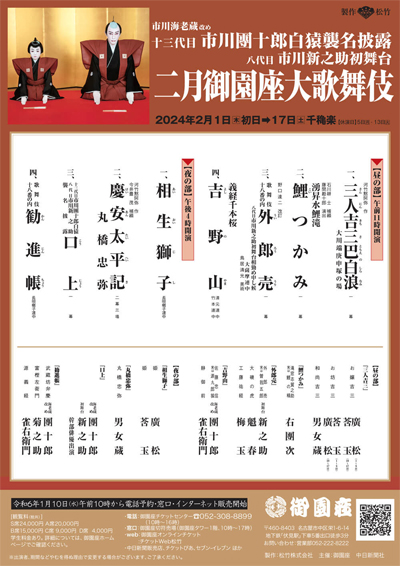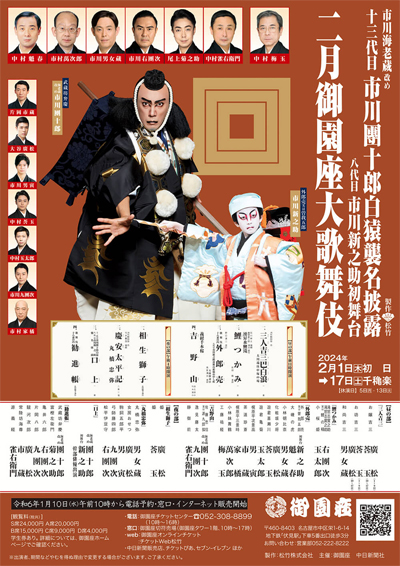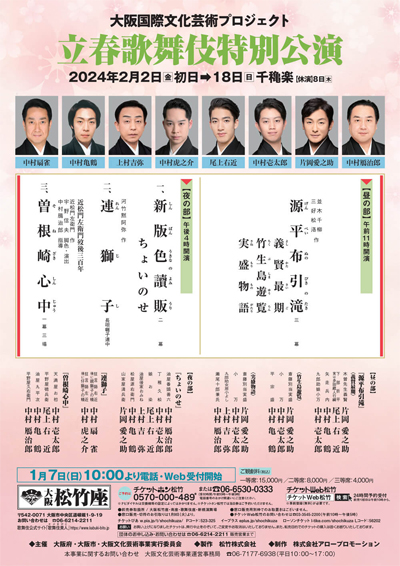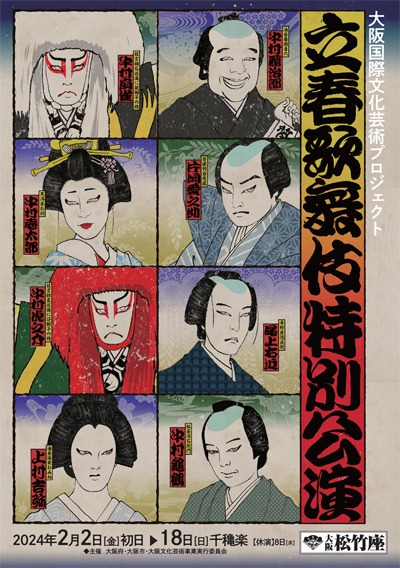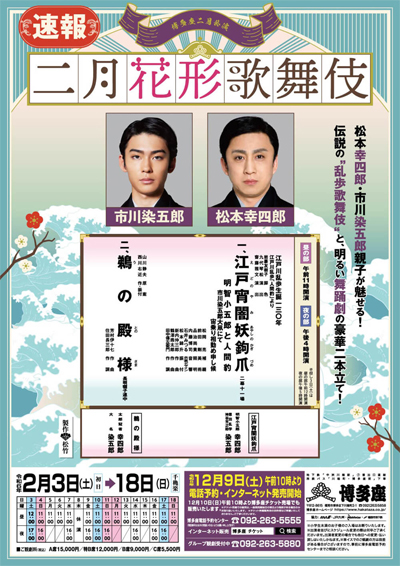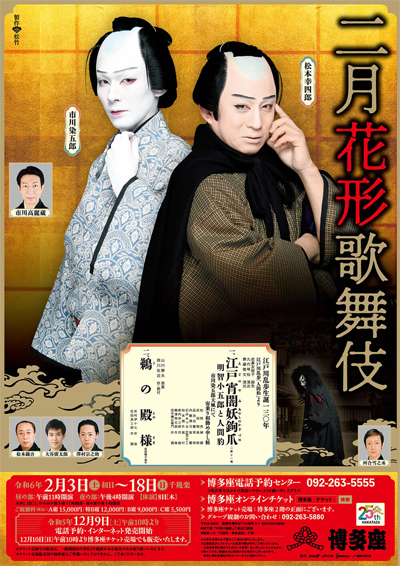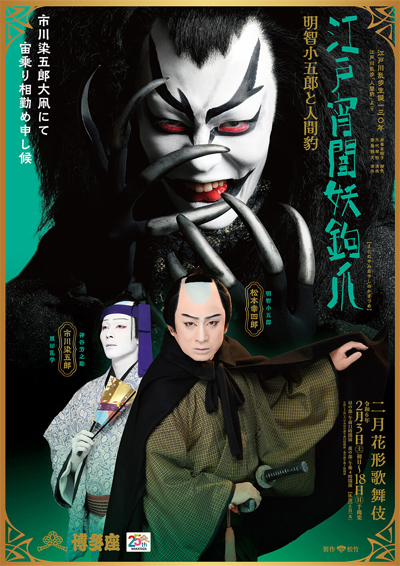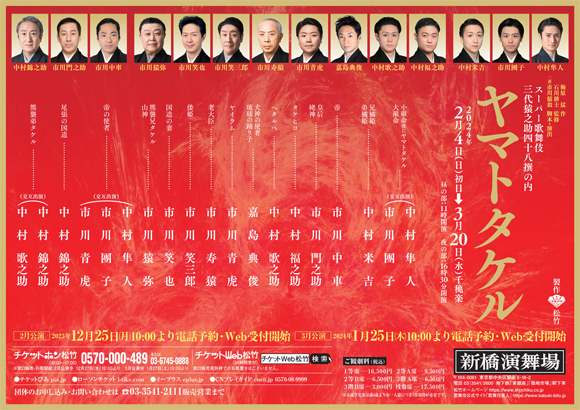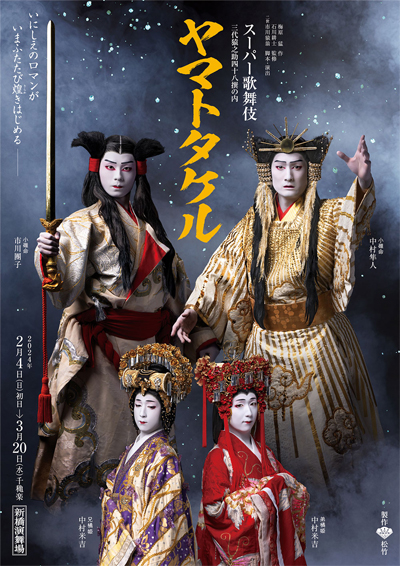| Comments |
The shűmei of Ichikawa Danjűr˘ XIII and the hatsubutai of Ichikawa Shinnosuke VIII
in Nagoya at the Misonoza.
Sannin Kichisa:
(Three Thieves Named Kichisa)
The playwright Kawatake Mokuami excelled at portrayals of thieves and this short scene,
with its music and poetic lines, is one of his most famous.
A beautiful young woman helps out a woman who is lost on the road.
But she is actually Oj˘ Kichisa, a male thief who is disguised as a woman.
He steals an immense sum of money that the woman is carrying and this leads to
an encounter on this riverbank of three thieves, all with the name Kichisa.
The two others Kichisa are Osh˘ Kichisa, a bonze turned thief, and Ob˘ Kichisa, an ex-samurai turned thief
Though they start out as rivals, they decide to become blood brothers
and form a gang. Featuring Nakamura Kangyoku/ďtani Hiromatsu as Oj˘ Kichisa, Ichikawa Omez˘ as Osh˘ Kichisa and ďtani Hiromatsu/Nakamura Kangyoku as Ob˘ Kichisa.
Koi Tsukami: a koi tsukami is a spectacular scene in a Kabuki drama, where a hero fights
in real water (honmizu) the spirit of a giant carp. During the Edo period,
it was developped by the Onoe clan, from Onoe Kikugor˘ I to Onoe Kikugor˘ III through Onoe Sh˘roku I.
In modern times, it became the trademark of the Ichikawa Udanji line. "Waki Noboru Mizu-ni Koi Taki", a rarely-staged drama,
was premiered in September 1914 at the Hong˘za of the drama "Waki Noboru Mizu-ni Koi Taki" [more details] and
it used the sekai of the Priest Seigen and the Princess Sakura. Starring Ichikawa Udanji and Nakamura Tamatar˘
in the roles of Takimado Shiganosuke (in reality the spirit of a giant carp) and Princess Kozakura.
Uir˘ Uri: there are many plays based on the revenge by the Soga brothers
on Kud˘ Suketsune (Living National Treasure Nakamura Baigyoku), the man that arranged to have their father killed.
In this particular play, this dramatic fight is transformed into light fantasy
by showing one of the Soga brothers disguised as a peddler of uir˘, a medicine
that makes it possible to speak quickly and elegantly. The highlight of the
play is a long speech full of puns and wordplays. Starring Ichikawa Shinnosuke as the peddler.
Also featuring Nakamura Kaishun, Ichikawa Omez˘, Kataoka Ichiz˘, Ichimura Manjir˘ and Ichimura Kakitsu.
Yoshinoyama: a dance travel scene from the epic "Yoshitsune Senbon Zakura".
Now in exile and disgrace, Yoshitsune has left his lover Shizuka in the safekeeping of his trusted retainer Tadanobu.
But she is unaware that this Tadanobu is actually a magical fox who has
disguised himself to be near the treasured drum that Shizuka carries,
a drum made from the skins of his fox parents.
Starring Ichikawa Danjűr˘ as Tadanobu, with Nakamura Jakuemon as Shizuka.
Featuring also Ichikawa Kudanji as Hayami no T˘ta.
Aioi Jishi: shishi (mythical lion-like spirits) are
usually thought of as vigorous masculine creatures, but when shishi dances were first adapted for Kabuki
from the classical N˘ theatre, they were danced by actors portraying an elegant, feminine atmosphere.
This dance is one of the earliest in the genre and stars onnagata female role specialists.
Featuring ďtani Hiromatsu and Nakamura Kangyoku.
Marubashi Chűya: this is a classic play by Kawatake Mokuami written
in the Meiji Period, when Kabuki could show historical events.
This is the story of Marubashi Chűya (Ichikawa Omez˘), who plotted to overthrow the
Edo government. He approaches Edo Castle pretending to be drunk, but
has actually come to measure the depth of the moat.
Unfortunately, he is observed by Izu-no-Kami (Ichikawa Udanji), one of the top officials of
the shogunate. Later, Chűya has a dispute with his wife and his wife's father,
that eventually leads to the failure of his revolt.
K˘j˘: the close relationship between the actors and the audience
is shown by these stage announcements, lavish ceremonies to commemorate various
important events. In this case, all the stars of the cast assemble to celebrate the shűmei of
Ichikawa Danjűr˘ XIII and the hatsubutai of Ichikawa Shinnosuke VIII.
Kanjinch˘: probably the most popular Kabuki play today,
it includes dance, comedy and the heart-warming pathos of a band of heroes
during their last days. Disguised as a band of traveling priests the
fugitive general Yoshitsune and his small band of retainers are stopped at a
road barrier. They escape only through the quick thinking of the head retainer,
a warrior priest named Musashib˘ Benkei, who improvises the text of an elaborate imperial
decree. Having escaped danger Benkei and the others describe their days of
glory and hardships on the road to escape in a moving dance.
This program stars Ichikawa Danjűr˘ in the role of Benkei,
with Nakamura Jakuemon and Onoe Kikunosuke as Yoshitsune and the barrier keeper Togashi.
Sources: Earphone Guide Website or Sh˘chiku Kabuki Official Website
|

